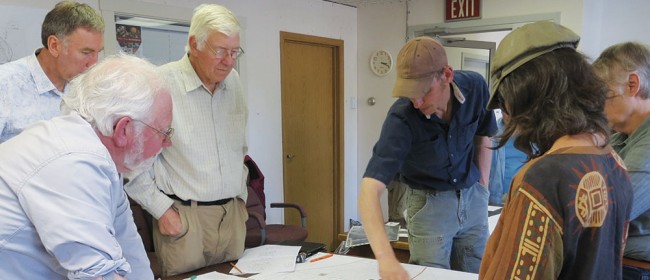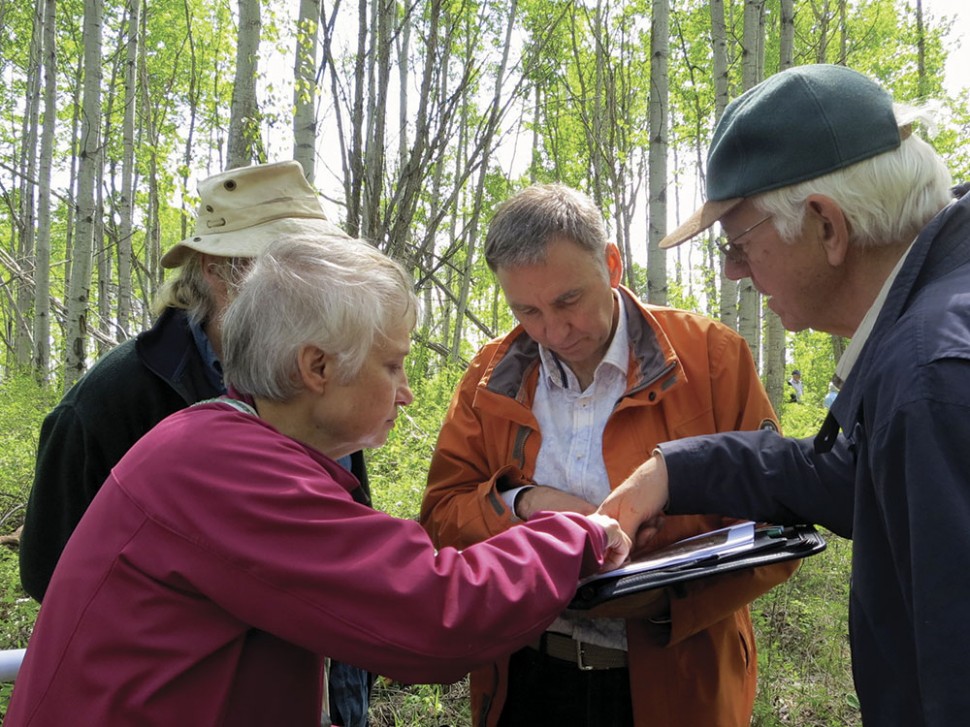
Photo Credit: Dina Hanson
Cohousing Communities A green alternative to the northern housing crunch
“We want to create a village, rather than just more housing.”
Daryl Hanson explains the ideas behind Birchwood Cohousing, a co-operative housing project located on a bench above the Village of Telkwa. A group of enthusiastic individuals, couples and families have been working together to design northern BC’s first cohousing community. Daryl and his wife, Dina, are dedicated participants in the undertaking.
“With some key funding from the Kassandra Trust, our feasibility study phase is almost completed. The next step will be to submit a development application to the village. We are hoping to receive approval to start construction in the fall of 2015,” Daryl explains.
Cohousing is not a new concept. Modern cohousing arose in Denmark in the 1960s in response to families unhappy with the isolating structures of post-World War II communities. Driven by the desire for social interaction and wanting to live in an ecologically friendly and sustainable environment, they founded the village of Saettedammen. This collaborative community was built around basic principles: a compact cluster of housing that left large areas of common space for walking and community interaction; green spaces for growing food and environmental integrity; common facilities for social activities and shared endeavours; and a consensus method of decision making. With the success of Saettedammen, the bofaellesskab or living community movement spread throughout northern Europe and North America. Today, over 500 cohousing communities can be found in Europe, United States, Canada and Australia.
Between generations
The Canadian Cohousing Network’s website provides an excellent source of information regarding cohousing projects. Eleven established cohousing communities are located in Saskatchewan, Ontario and British Columbia. Almost another 15 projects are in the planning or development phases. Some projects, such as Cranberry Commons Cohousing in Burnaby and Creekside Commons in Courtnay, are multi-generational facilities whereas others, such as Elderberry Cohousing in Chilliwack and Harbourside Cohousing in Sooke, focus on seniors’ housing.
According to Dina, who will be one of Birchwood’s residents, the Telkwa project will be a multi-generational facility, including young families with children, singles and couples still actively working, and retirees. A multi-generational village allows different age groups to be supportive of each other and to pass on knowledge between generations.
“A shared community is more natural with children present,” Dina explains. Her husband agrees. “With my grandchildren so far away, I am looking forward to having children around,” Daryl says. “I am eager to do things, like go fishing, with these families.”
Unlike the communes of the 1960s and 1970s, cohousing is based on an aggregation of private homes that share common facilities and services. Lots are privately owned in the Birchwood Cohousing village, but partners share responsibility for common grounds andvial complex should contain 18 homes in two clusters, with a 3,000-square-foot common house located between the clusters. With 18 homes, according to Dina, the group will be large enough to share in the functioning of the village, but small enough to develop communication and cooperation between participants.
Smaller. Local. Accessible.
Birchwood closely follows the primary goals associated with the concepts of cohousing and shared living. By building smaller houses and using common buildings for community activities, the carbon footprint is significantly reduced. Wherever possible, local materials and building methods will be used for construction and maintenance. Common areas will be designed to meet all accessibility and mobility standards. Houses will be wired for solar energy and may even generate enough power to feed back into the provincial power grid.
Sustainable food production is another important component of the Telkwa project.Permaculture concepts will be used for landscaping and garden areas. According to Dina, “We are all passionate gardeners and the location is excellent for growing.”
This sentiment is voiced by participant Jeannie Boyce, a retired nurse. The chance to grow food and even become a centre for local agriculture is a major attraction for her and her husband’s participation in the project.
“I have lived in Smithers for 40 years,” she says, “and the thought of downsizing is a bit daunting. But I need to realize that this is the time to make a move. I am quite excited about moving to Telkwa. It is a beautiful location and has better air and gets more sunshine than Smithers.” The cooperative and sustainability concepts of the cohousing project match her goals for an environmentally meaningful and active lifestyle into her retirement years.
“Cohousing honours both privacy and the development of a sense of community,” says Mel Coulson, originator of the idea for a cohousing project in the Bulkley Valley. Worried about how modern society has become more insular and isolated in the last few decades, he feels that cohousing is one way to purposefully come together to create common goals and shared ideas about the Earth’s future.
On a practical basis, Mel says, cohousing is a meaningful way for people to help each other, reduce their cost of living, develop a community of caring neighbours, and reduce costs to the healthcare system. In May, Margaret Critchlow, founding director of the Canadian Senior Cohousing Society and a founding member of Harbourside seniors’ cohousing in Sooke, told a seniors’ housing conference at Simon Fraser University, “Do you know that social isolation is more likely to kill you than smoking?”
Sustainable Village
Cohousing has the potential to become an important option in northern BC in terms of addressing both the issue of affordable housing for young families and the need for suitable housing for seniors and individuals wishing to downsize. The concept of a supportive village atmosphere with environmentally sustainable and economically efficient living meets many goals of northerners faced with rising costs generated by transnational industrial development in this part of the province.
As Daryl explains, cohousing may be considered cutting edge by some, but its principles are based upon hundreds of years of sustainable village life before the industrial revolution turned society toward the perils of climate change and overexploitation of resources. He, and the others in the Birchwood cohousing group, are looking forward to their future in a purposefully designed community that is environmentally and humanity friendly.
The Birchwood Cohousing participants encourage families and individuals from throughout northern BC to consider joining their project or to contact them for further information if they are considering a cohousing project in their own area. For further information, contact info@birchwoodcohousing.com or look for the Birchwood Cohousing web page in early 2015.







